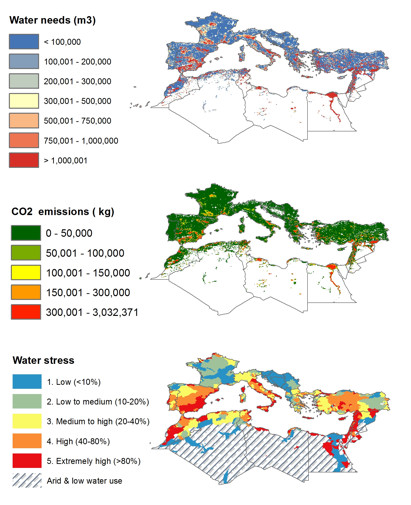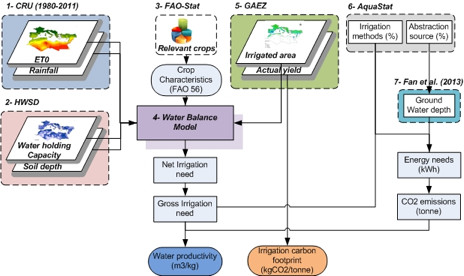Assessing water and energy footprint of irrigated agriculture in the Mediterranean
Abstract
Agriculture in the Mediterranean, one of the water scarcest regions in the world is by far the largest water consuming sector. Dwindling water supply, increase in drought frequency and uncertainties associated with climate change have raised the alerts on the region’s food security and environmental sustainability. In this study, a large geo-database of global climate, soil and crop were combined with national irrigation statistics to run a water balance model to estimate the theoretical irrigation volumetric needs of the Mediterranean main strategic crops and their relative CO2emissions. When associated with the reported crop yield and water resources availability, the spatial variability of water (m3/kg) and energy (CO2/kg) productivity across the Mediterranean region are obtained and vulnerable areas are identified. The estimated total water needs for the Mediterranean irrigated agriculture under current climate, land cover and irrigation methods was estimated to be around 46km3/year releasing more than 3Mt of CO2in the atmosphere only from water abstraction and farm application. Currently, 59% of total irrigation water needs are located in catchments that are classified as under high and extremely high water risk. With climate change, water resources are expected to become scarcer and agriculture more dependent on irrigation to satisfy the continuous increase in food demand. Adaptation and mitigation options to tackle water scarcity and improve productivity under current and future climate will be discussed.

Fig. 1.

Fig. 2.
Full Text:
Poster (PDF)References
FAO/IIASA, 2010. Global Agro-ecological Zones (GAEZ v3.0). FAO, Rome, Italy and IIASA, Laxenburg, Austria.
Gassert, F., M. Luck, M. Landis, P. Reig, and T. Shiao. 2013. “Aqueduct Global Maps 2.0.” Working Paper. Washington, DC: World Resources Institute.
Harris, I., Jones, P.D., Osborn, T.J., and Lister, D.H (2013). Updated high-resolution grids of monthly climatic observations. In press, Int. J. Climatol., Doi: 10.1002/joc.3711
Previous issues and volumes can be found in the 'Archives' section.
You can refer to a paper published in this series in the following format Author (2013) Title. FACCE MACSUR Reports 2: D-C1.3, where "D-C1.3" is the article ID en lieu of page range.